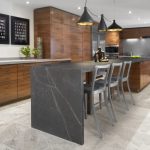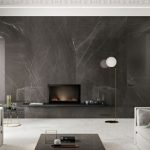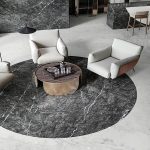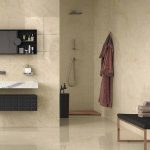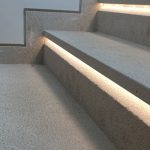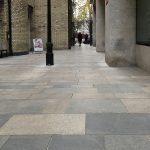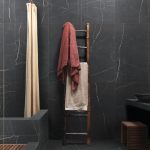Veneer and Tiles Two Common Approaches to Granite for Wall Applications
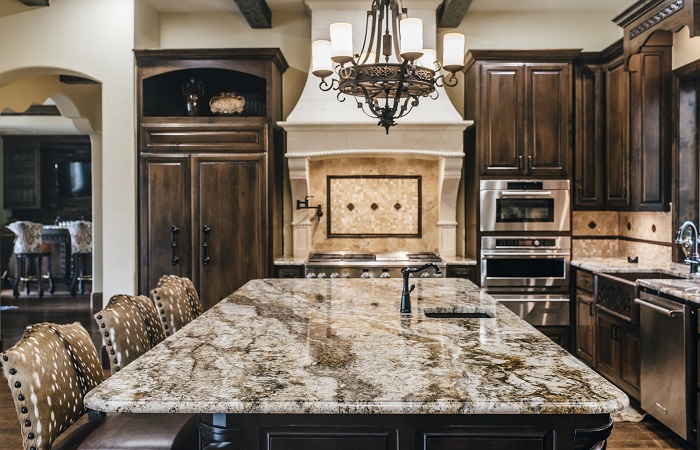
Veneer and Tiles Two Common Approaches to Granite for Wall Applications: Granite Properties and Uses
Veneer and tiles are two common approaches to granite for wall applications. Granite is a common type of felsic intrusive igneous rock that is granular and phaneritic in texture. Granites can be predominantly white, pink, or gray in color, depending on their mineralogy. The word granite comes from the Latin granum, a grain, in reference to the coarse-grained structure of such a holocrystalline rock. Strictly speaking, granite is an igneous rock with between 20% and 60% quartz by volume, and at least 35% of the total feldspar consisting of alkali feldspar, although commonly the term granite is used to refer to a wider range of coarse grained igneous rocks containing quartz and feldspar.
Granitic Rock
The term granitic means granite-like and is applied to granite and a group of intrusive igneous rocks with similar textures and slight variations in composition and origin. These rocks mainly consist of feldspar, quartz, mica, and amphibole minerals, which form an interlocking, somewhat equigranular matrix of feldspar and quartz with scattered darker biotite mica and amphibole (often hornblende) peppering the lighter color minerals. Occasionally some individual crystals (phenocrysts) are larger than the groundmass, in which case the texture is known as porphyritic.
Granitoid
A granitic rock with a porphyritic texture is known as a granite porphyry. Granitoid is a general, descriptive field term for lighter-colored, coarse-grained igneous rocks. Petrographic examination is required for identification of specific types of granitoids. The extrusive igneous rock equivalent of granite is rhyolite.
Granites is nearly always massive that is lacking any internal structures, hard and tough, and therefore it has gained widespread use throughout human history as a construction stone. The melting temperature of dry granite at ambient pressure is 1215–1260 °C; it is strongly reduced in the presence of water, down to 650 °C at a few kBar pressure. Granites has poor primary permeability, but strong secondary permeability.
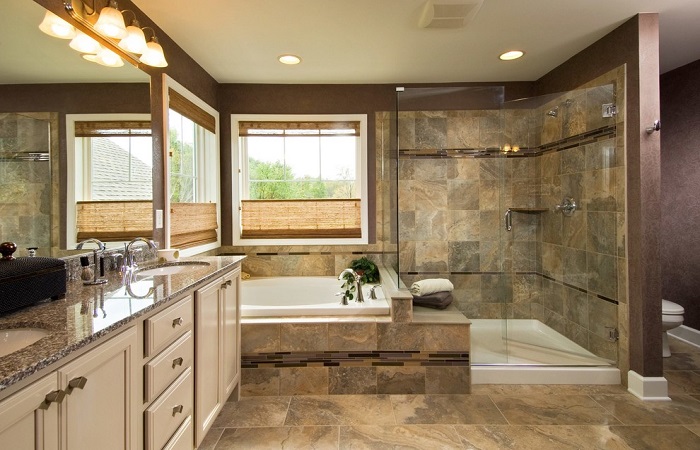
Granite Origin
Granites has a felsic composition and is more common in recent geologic time in contrast to Earth’s ultramafic ancient igneous history. Felsic rocks are less dense than mafic and ultramafic rocks, and thus they tend to escape subduction, whereas basaltic or gabbroic rocks tend to sink into the mantle beneath the granitic rocks of the continental cratons. Therefore, granitic rocks form the basement of all land continents.
Geochemical Origins
Granitoids have crystallized from magmas that have compositions at or near a eutectic point or a temperature minimum on a cotectic curve. Magmas will evolve to the eutectic because of igneous differentiation, or because they represent low degrees of partial melting. Fractional crystallisation serves to reduce a melt in iron, magnesium, titanium, calcium and sodium, and enrich the melt in potassium and silicon – alkali feldspar (rich in potassium) and quartz (SiO2), are two of the defining constituents of granites.
Mineralogy, Texture and Chemical Granite Composition
This process operates regardless of the origin of the parental magma to the granites, and regardless of its chemistry. However, the composition and origin of the magma that differentiates into granite leaves certain geochemical and mineral evidence as to what the granite’s parental rock was. The final mineralogy, texture and chemical composition of a granites is often distinctive as to its origin. For instance, a granite that is formed from melted sediments may have more alkali feldspar, whereas a granites derived from melted basalt may be richer in plagioclase feldspar. It is on this basis that the modern “alphabet” classification schemes are based. Granite has a slow cooling process which forms larger crystals.
Formation of Granite
Granite is, quite literally, as old as the earth. It was formed from liquid magma, the molten rock still found at the core of the planet, which was pushed toward the surface to form a substance approaching the hardness and durability of diamond. Granite is an igneous rock, the name reflecting its fiery beginnings. The chemical composition of granite is similar to that of lava. However, granite owes its hardness and density to the fact that it has been solidified deep within the earth, under extreme pressure.
Over the eons, seismic activity has changed the crust of the planet, forcing veins of granite to the surface. Glaciers scraped off layers of dirt, sand and rock to expose granite formations. Typically revealed by outcrops, these deposits have been discovered on every continent.
Granites Expression
It is accurate to refer to granites in the plural sense, because many varieties of the stone exist. While they differ in color, texture and crystalline structure, the granites have three essential minerals in common: Feldspar (50 percent or greater), Quartz (25 to 40 percent), Mica (three to 10 percent). These minerals occur in differing proportions, giving each granite its own unique characteristics. Other minerals also may be present in smaller amounts, adding to the variation in color and texture of each granite deposit. As with other natural products, many granites contain a certain amount of grain “movement” or flowing veins in the stone. Many people find this flow and blending of colors to be the most compelling reason for using granite.
Quarrying and Fabrication
Granite has been quarried systematically as far back as 4000 B.C. long before hardened metals were used. Over the centuries, quarrying techniques evolved very slowly until the 20th century when industrial techniques allowed large quantities of stone to be quarried in a cost effective manner. Low-compression explosives and drive-in quarrying methods are used to remove large blocks of granite from deposits close to the earth’s surface.
The granite blocks are then shipped from the quarry by truck or rail to a fabrication facility where they are sawed into slabs of the desired thickness. Each slab is then processed through automatic equipment for the required finish application. Due to the extreme hardness of granite, much of the fabrication process requires the use of diamond-edge saw blades or a slurry containing diamonds which contributes significantly to the cost of the finished product.
Granite with Versatile Applications
Granite is an igneous rock with versatile applications. It is the most popular choice for flooring because of its overall resiliency, strength and unique color options. Apart from flooring, granite slabs are also used for kitchen countertops, wash area, balcony, table tops and dining area. Granite tiles are best for wall cladding. granites at prices equivalent to, and in some cases, less than man-made granite look-alikes and solid surface materials.
Design Characteristics
The increasing demand for stone use in a wide variety of building applications requires increased knowledge about the different types of stone available and their proper use. The most common are granite, marble, limestone, travertine and sandstone. Each stone has unique physical characteristics which affect its applicability to a specific design. While each type of stone has a place in modern construction, granite and marble are the most often used for interior applications. They both allow for a highly polished surface and provide many beautiful options. They are, however, very different.
Granite is the hardest of all building stones with a very dense grain, making it virtually impervious to stain and uniquely applicable for any interior use. If polished, its high-gloss finish will endure even in harsh environments. These characteristics are ideal for countertops and flooring, making granite a reliable stone for these applications. Granite also can be provided with a variety of other finishes and, when combined with the vast spectrum of colors available, provide design options surpassing any other type of stone. Granites may contain other minerals providing patterned movement or they may be quarried with consistent grains and little movement.
Interior Applications
Today, interior spaces can be as big as all outdoors. Open spaces, greenery, walkways and water blend to provide a comfortable garden look to common areas. Granite veneer and tiles are natural options for interior landscaping. As a countertop material, floor and wall covering, stairway, waterfall or planter, granite is durable and clearly a beautiful option.
Two Common Approaches to Granite for Wall Applications
Two common approaches to granite for wall applications includes veneer and tiles. Generally, with 3/8- or 1/2- inch granite tile, some flexibility may be sacrificed with regard to piece size, color and finish. Tile can be set with thin-set mortar; no mechanical attachment is used. Any tile application also can be completed with 3/4 inch or thicker granite veneer. This thicker granite is available in most colors and in a wide variety of piece sizes, allowing for virtually unlimited flexibility. A 3/4-inch veneer is thick enough to permit mechanical attachment which will allow for safe granite use in vertical interior applications.
Granite Popularity
In recent years, granite veneer and tiles has increased significantly in popularity as a residential material.
It is used primarily as countertop and flooring material in both single and multiple family housing projects. Part of this popularity results from the recognition of granite countertops, fireplace surrounds and floor tile as a long-term investment. With its deep, iridescent colors, granite offers an elusive, one-of-a-kind beauty created only by nature.
Due to their extreme hardness, second only to diamonds, granite countertops are an ideal work surface. Granite’s polished finish will not wear off and, unlike marble and synthetic countertops, granite will not blister, scratch or crack. It is highly stain resistant and will not become burned or marred if hot pans are set directly on the surface. In fact, because of its cooling characteristics and its extremely smooth, hard surface, countertops made of polished granite are ideal for kneading bread dough.
Granite Fabrications
With the combination of many different countertop edge treatments and the virtually unlimited variety in color, granite countertops and bathroom vanity tops can work beautifully with any design scheme. Final fabrication and installation of granite countertops should be handled by an experienced, professional stone fabricator. Special equipment and procedures are required to ensure level surfaces, proper jointing and safe handling of granite.
Most granite countertops are fabricated with 1 1/4-inch-thick granite because of its increased vertical slab strength, less chance for breakage and ease of fabrication. Once the slabs are chosen, the fabricator will take care of the necessary cutting for sink holes, corners and any other requirements to achieve a proper fit. The fabricator also will finish the exposed countertop edge according to customer specifications.
If 3/4-inch granite is to be used, a plywood underlayment is attached to increase structural support and a second layer of stone is laminated on the edge of the slab in order to obtain a more substantial looking edge treatment. This lamination occurs prior to edge finishing. Due to the decrease in labor, the overall strength of the thicker material and the relatively minor increase in cost, most home owners prefer the 1 1/4-inch material.
Granite Tiles
Tiles of granite may be installed over most sound, level substrates. Granite tiles also may be used for countertops, fireplace surrounds and vanity tops. The method of application will vary to suit the specific type of substrate. Thin granite tiles are installed by tile setters in a manner similar to ceramic tile, using the same setting techniques, materials and tools.
It is important to know that granite flooring often is given a thermal finish, either for aesthetic or safety reasons. This is a flaming process which disintegrates a percentage of the surface crystals, leaving the stone with a rough but uniform finish.
Maintenance of Surfaces
Maintenance of granite surfaces is easy. For daily maintenance, a solution of clear, non-sudsing ammonia or a mild neutral detergent and water is recommended. Care should be taken to make sure the detergent is non-abrasive. On occasion, although granite is very solid and non-porous, spills left on the surface for an extended time period may leave some residual staining.
These stains usually dissipate over time on their own. If immediate removal is desired, a simple poultice powder found at most cleaning supply outlets may be used. Additionally, local fabricators can usually provide recommendations regarding extraordinary maintenance should the need arise.
Final Statement
Beauty, design flexibility, durability, value, customer satisfaction–these are the primary advantages of using granite. No matter what the interior application may be, granite will continually look as elegant as the day it was installed. Whenever life-cycle costing formulas are applied, granite is a top performer.
To learn more about us, click here.
Send your price quotes directly to our WhatsApp through this Link: https://wa.link/ord5k8
Sources
www.advancedgranite.com/resources/properties-and-applications/
www.glittek.com/applications.php
www.worldofstones.com/blog/granite/
- Back To Articles
- granite, granite applications, granite characteristics, granite decor, granite decoration, granite design, granite exterior design, granite fabrication, granite features, granite highlights, granite interior design, Granite Origin, granite quarrying, granite stone, granite uses, Granite Versatile Applications, Granite with Versatile Applications, Granitic Rock, natural stone, tiles, veneer
Article
Natural Stone Applications
- 22 December 2022
Iranian Stones Introduction According to Source and Quarry
- 21 December 2022
Technical Stone Introduction and Quarrying Procedures
- 21 December 2022
Categories
- blog757
- news1
- Specialized articles756

